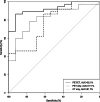Preoperative prediction of pathological grade in pancreatic ductal adenocarcinoma based on 18F-FDG PET/CT radiomics
- PMID: 33630176
- PMCID: PMC7907291
- DOI: 10.1186/s13550-021-00760-3
Preoperative prediction of pathological grade in pancreatic ductal adenocarcinoma based on 18F-FDG PET/CT radiomics
Abstract
Purpose: To develop and validate a machine learning model based on radiomic features derived from 18F-fluorodeoxyglucose (18F-FDG) positron emission tomography/computed tomography (PET/CT) images to preoperatively predict the pathological grade in patients with pancreatic ductal adenocarcinoma (PDAC).
Methods: A total of 149 patients (83 men, 66 women, mean age 61 years old) with pathologically proven PDAC and a preoperative 18F-FDG PET/CT scan between May 2009 and January 2016 were included in this retrospective study. The cohort of patients was divided into two separate groups for the training (99 patients) and validation (50 patients) in chronological order. Radiomics features were extracted from PET/CT images using Pyradiomics implemented in Python, and the XGBoost algorithm was used to build a prediction model. Conventional PET parameters, including standardized uptake value, metabolic tumor volume, and total lesion glycolysis, were also measured. The quality of the proposed model was appraised by means of receiver operating characteristics (ROC) and areas under the ROC curve (AUC).
Results: The prediction model based on a twelve-feature-combined radiomics signature could stratify PDAC patients into grade 1 and grade 2/3 groups with AUC of 0.994 in the training set and 0.921 in the validation set.
Conclusion: The model developed is capable of predicting pathological differentiation grade of PDAC based on preoperative 18F-FDG PET/CT radiomics features.
Keywords: 18F-FDG PET/CT; Machine learning; Pancreatic cancer; Radiomics; XGBoost.
Conflict of interest statement
The authors declare that they have no competing interests.
Figures





Similar articles
-
Radiomics analysis for the differentiation of autoimmune pancreatitis and pancreatic ductal adenocarcinoma in 18 F-FDG PET/CT.Med Phys. 2019 Oct;46(10):4520-4530. doi: 10.1002/mp.13733. Epub 2019 Aug 13. Med Phys. 2019. PMID: 31348535
-
Radiomics-based histological grading of pancreatic ductal adenocarcinoma using 18F-FDG PET/CT: A two-center study.Eur J Radiol. 2025 Jun;187:112070. doi: 10.1016/j.ejrad.2025.112070. Epub 2025 Mar 30. Eur J Radiol. 2025. PMID: 40187196
-
A multidomain fusion model of radiomics and deep learning to discriminate between PDAC and AIP based on 18F-FDG PET/CT images.Jpn J Radiol. 2023 Apr;41(4):417-427. doi: 10.1007/s11604-022-01363-1. Epub 2022 Nov 21. Jpn J Radiol. 2023. PMID: 36409398 Free PMC article.
-
Hyperaccumulation of (18)F-FDG in order to differentiate solid pseudopapillary tumors from adenocarcinomas and from neuroendocrine pancreatic tumors and review of the literature.Hell J Nucl Med. 2013 May-Aug;16(2):97-102. doi: 10.1967/s002449910084. Epub 2013 May 20. Hell J Nucl Med. 2013. PMID: 23687644 Review.
-
A review on advances in 18F-FDG PET/CT radiomics standardisation and application in lung disease management.Insights Imaging. 2022 Feb 5;13(1):22. doi: 10.1186/s13244-021-01153-9. Insights Imaging. 2022. PMID: 35124733 Free PMC article. Review.
Cited by
-
Radiomics in Oncological PET Imaging: A Systematic Review-Part 2, Infradiaphragmatic Cancers, Blood Malignancies, Melanoma and Musculoskeletal Cancers.Diagnostics (Basel). 2022 May 27;12(6):1330. doi: 10.3390/diagnostics12061330. Diagnostics (Basel). 2022. PMID: 35741139 Free PMC article. Review.
-
Construction of feature selection and efficacy prediction model for transformation therapy of locally advanced pancreatic cancer based on CT, 18F-FDG PET/CT, DNA mutation, and CA199.Cancer Cell Int. 2025 Jan 19;25(1):19. doi: 10.1186/s12935-025-03639-8. Cancer Cell Int. 2025. PMID: 39828699 Free PMC article.
-
Artificial intelligence in pancreatic cancer.Theranostics. 2022 Oct 3;12(16):6931-6954. doi: 10.7150/thno.77949. eCollection 2022. Theranostics. 2022. PMID: 36276650 Free PMC article. Review.
-
Clinical-radiomics nomogram using contrast-enhanced CT to predict histological grade and survival in pancreatic ductal adenocarcinoma.Front Oncol. 2023 Sep 4;13:1218128. doi: 10.3389/fonc.2023.1218128. eCollection 2023. Front Oncol. 2023. PMID: 37731637 Free PMC article.
-
Setting the Research Agenda for Clinical Artificial Intelligence in Pancreatic Adenocarcinoma Imaging.Cancers (Basel). 2022 Jul 19;14(14):3498. doi: 10.3390/cancers14143498. Cancers (Basel). 2022. PMID: 35884559 Free PMC article. Review.
References
Grants and funding
LinkOut - more resources
Full Text Sources
Other Literature Sources

